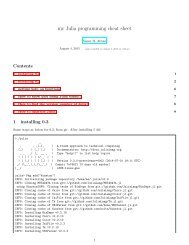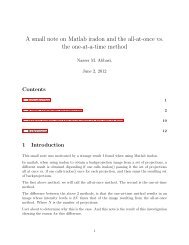You also want an ePaper? Increase the reach of your titles
YUMPU automatically turns print PDFs into web optimized ePapers that Google loves.
Or in full form<br />
and<br />
⎧ ⎫ ⎡<br />
⎨η 1 (0) ⎬<br />
⎩<br />
η 2 (0)<br />
⎭ = ⎣<br />
⎧ ⎫ ⎡<br />
⎨η 1 ′ (0) ⎬<br />
⎩<br />
η 2 ′ (0) ⎭ = ⎣<br />
⎤T ⎡<br />
õ1<br />
ϕ 11 √µ2<br />
ϕ 12<br />
⎦<br />
õ1<br />
ϕ 21 √µ2<br />
ϕ 22<br />
⎤T ⎡<br />
õ1<br />
ϕ 11 √µ2<br />
ϕ 12<br />
⎦<br />
õ1<br />
ϕ 21 √µ2<br />
ϕ 22<br />
⎣ m 11 m 12<br />
m 21<br />
⎣ m 11 m 12<br />
m 21<br />
⎤ ⎧ ⎫<br />
⎨x ⎦ 1 (0) ⎬<br />
m<br />
⎩<br />
22 x 2 (0)<br />
⎭<br />
⎤ ⎧ ⎫<br />
⎨x ⎦<br />
′ 1 (0) ⎬<br />
m<br />
⎩<br />
22 x ′ 2 (0) ⎭<br />
Each of these EOM are solved using any of the standard methods. This will result is solutions η 1 (t) and<br />
η 2 (t)<br />
1.7 Step 7. Converting modal solution to normal coordinates solution<br />
The solutions found above are in modal coordinates η 1 (t) , η 2 (t). The solution needed is x 1 (t) , x 2 (t). Therefore,<br />
the transformation {x} = [Φ] {η} is now applied to convert the solution to normal coordinates<br />
⎧ ⎫ ⎡ ⎤ ⎧ ⎫<br />
⎨x 1 (t) ⎬ √µ1<br />
ϕ 11 √µ2<br />
ϕ 12 ⎨<br />
⎩<br />
x 2 (t)<br />
⎭ = η<br />
⎣ ⎦ 1 (t) ⎬<br />
õ1<br />
ϕ 21 √µ2<br />
ϕ 22 ⎩<br />
η 2 (t)<br />
⎭<br />
⎧<br />
⎫<br />
⎨ √µ1<br />
ϕ 11<br />
η 1 (t) + √ ϕ 12<br />
µ2<br />
η 2 (t) ⎬<br />
=<br />
⎩ √µ1<br />
ϕ 21<br />
η 1 (t) + √ ϕ 22<br />
µ2<br />
η 2 (t)<br />
⎭<br />
Hence<br />
and<br />
x 1 (t) = ϕ 11<br />
√<br />
µ1<br />
η 1 (t) + ϕ 12<br />
√<br />
µ2<br />
η 2 (t)<br />
x 2 (t) = ϕ 21<br />
√<br />
µ1<br />
η 1 (t) + ϕ 22<br />
√<br />
µ2<br />
η 2 (t)<br />
Notice that the solution in normal coordinates is a linear combination of the modal solutions. The terms<br />
ϕ<br />
√ ij<br />
µ<br />
are just scaling factors that represent the contribution of each modal solution to the final solution. This<br />
completes modal analysis<br />
1.8 Numerical solution using modal analysis<br />
This is a numerical example that implements the above steps using a numerical values for [K] and [M].<br />
Let k 1 = 1, k 2 = 2, m 1 = 1, m 2 = 3 and let f 1 (t) = 0 and f 2 (t) = sin (5t). Let initial conditions be<br />
x 1 (0) = 0, x ′ 1 (0) = 1, x 2 (0) = 1.5, x ′ 2 (0) = 3, hence<br />
⎧ ⎫ ⎫<br />
⎨x 1 (0) ⎬ 0⎬<br />
⎧<br />
⎨<br />
⎩<br />
x 2 (0)<br />
⎭ = ⎩<br />
1<br />
⎭<br />
and<br />
⎧ ⎫ ⎧ ⎫<br />
⎨x ′ 1 (0) ⎬ ⎨<br />
⎩<br />
x ′ 2 (0) ⎭ = 1.5⎬<br />
⎩<br />
3<br />
⎭<br />
In normal coordinates, the EOM are<br />
9





